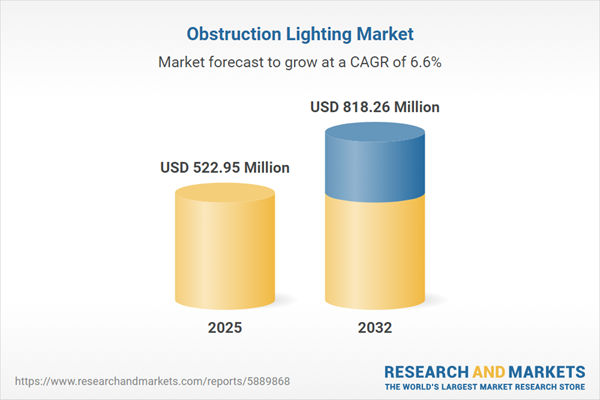Speak directly to the analyst to clarify any post sales queries you may have.
The obstruction lighting market is rapidly evolving as the need for advanced safety solutions across critical infrastructure projects intensifies. Modern aerial safety requirements and regulatory trends are shaping how industry leaders assess, invest, and future-proof their obstruction lighting strategies.
Market Snapshot: Obstruction Lighting Market Growth and Dynamics
The global obstruction lighting market grew from USD 490.47 million in 2024 to USD 522.95 million in 2025 and is forecasted to achieve USD 818.26 million by 2032, with a CAGR of 6.60%. This robust trajectory reflects sustained investment in aviation safety, the expansion of wind and telecom infrastructure, and the adoption of digital and energy-efficient lighting technologies. The market’s momentum is driven by a convergence of regulatory compliance, emerging installation environments, and heightened environmental parameters influencing both urban and remote infrastructure development.
Scope & Segmentation: Extensive Coverage by Region, Technology, and Application
- Technology Types: LED (including dual color, red, and white), Incandescent (dual color, red, white), Metal Halide
- Application Areas: Bridges, Buildings, Chimneys, Telecommunication Towers, Wind Turbines
- Intensity Classes: High Intensity, Medium Intensity, Low Intensity
- Installation Modes: New Installation, Retrofit
- End User Groups: Infrastructure Developers, Renewable Energy Operators, Telecom Operators
- Regional Coverage: Americas (North America—United States, Canada, Mexico; Latin America—Brazil, Argentina, Chile, Colombia, Peru), Europe, Middle East & Africa (Europe—United Kingdom, Germany, France, Russia, Italy, Spain, Netherlands, Sweden, Poland, Switzerland; Middle East—United Arab Emirates, Saudi Arabia, Qatar, Turkey, Israel; Africa—South Africa, Nigeria, Egypt, Kenya), Asia-Pacific (China, India, Japan, Australia, South Korea, Indonesia, Thailand, Malaysia, Singapore, Taiwan)
- Key Players: Signify N.V., Eaton Corporation plc, OSRAM GmbH, Zumtobel Group AG, Dialight PLC, Carmanah Technologies Corporation, Sabik Offshore AB, ADB Safegate Oy Ab, E2S Warning Signals Limited, Den Haan Rotterdam B.V.
Key Takeaways: Strategic Insights for Decision-Makers
- LED adoption is transforming lifecycle cost management by reducing energy consumption and enabling remote monitoring through advanced control systems.
- Stakeholders are navigating complex regulatory landscapes, with frequent technical updates around light intensity, color calibration, and installation protocols.
- Sustainability pressures are driving innovation, yielding smarter dimming algorithms, reduced light pollution, and adaptive systems for wildlife and ecological protection.
- End users across infrastructure, renewable energy, and telecom emphasize tailored solutions that balance compliance with operational efficiency and minimal maintenance.
- Regional disparities in regulatory enforcement and infrastructure modernization create localized opportunities and challenges for market entry and product adaptation.
- Manufacturers invest in R&D collaborations to deliver resilient, digital-ready lighting platforms suited for challenging environments, including marine and high-wind applications.
Tariff Impact: Adjusting to Shifting Cost Structures and Supply Chain Realities
Recent revisions to US tariffs have increased costs for steel, aluminum, and semiconductors—core components of obstruction lighting products. These changes are prompting manufacturers to strengthen local supply chains and reevaluate sourcing partnerships. By diversifying suppliers and investing in domestic manufacturing capabilities, industry leaders seek to manage tariff volatility and enhance cost predictability throughout their procurement cycles.
Obstruction Lighting Market Research Methodology & Data Sources
This report employs a mixed-method research approach, integrating in-depth interviews with decision-makers, targeted surveys of procurement and maintenance specialists, and comprehensive secondary analysis of technical papers, regulatory materials, and proprietary databases. Each data point has undergone expert validation and multi-stage consistency checks for accuracy.
Why This Report Matters: Informed Decision-Making for Industry Leaders
- Provides actionable guidance on technology selection, risk management, and compliance in a rapidly-evolving obstruction lighting sector.
- Enables strategic planning by anticipating region-specific regulatory, environmental, and operational challenges.
- Empowers stakeholders to align product portfolios and investment strategies with market dynamics and end-user priorities.
Conclusion
The obstruction lighting market is defined by evolving regulatory requirements and digital innovation. Leaders who embrace smart, resilient, and adaptive lighting solutions will strengthen their position and meet both compliance and operational demands in this market.
Additional Product Information:
- Purchase of this report includes 1 year online access with quarterly updates.
- This report can be updated on request. Please contact our Customer Experience team using the Ask a Question widget on our website.
Table of Contents
3. Executive Summary
4. Market Overview
7. Cumulative Impact of Artificial Intelligence 2025
Companies Mentioned
The companies profiled in this Obstruction Lighting market report include:- Signify N.V.
- Eaton Corporation plc
- OSRAM GmbH
- Zumtobel Group AG
- Dialight PLC
- Carmanah Technologies Corporation
- Sabik Offshore AB
- ADB Safegate Oy Ab
- E2S Warning Signals Limited
- Den Haan Rotterdam B.V.
Table Information
| Report Attribute | Details |
|---|---|
| No. of Pages | 188 |
| Published | October 2025 |
| Forecast Period | 2025 - 2032 |
| Estimated Market Value ( USD | $ 522.95 Million |
| Forecasted Market Value ( USD | $ 818.26 Million |
| Compound Annual Growth Rate | 6.6% |
| Regions Covered | Global |
| No. of Companies Mentioned | 11 |









